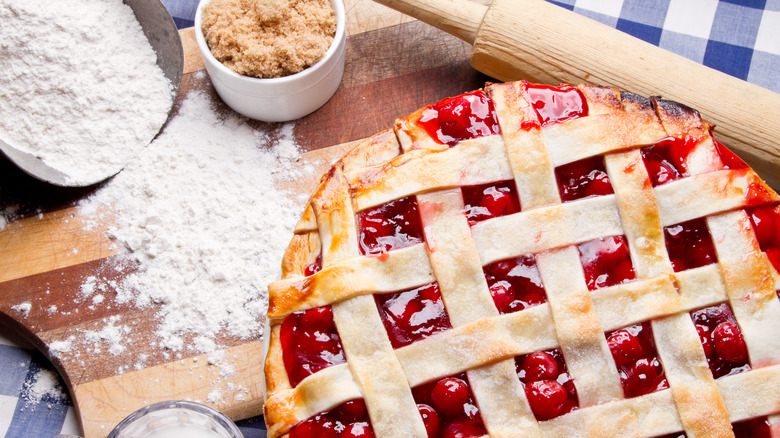The Crucial Step To Keep In Mind When Baking Pies With Frozen Fruit
If you love to bake –- and many of us do -– then you're likely always looking for ways to strengthen your pie game. Whether learning how to blind bake your crust or elevating your homemade fillings, there's always a new technique to be mastered or a new hack to be hacked.
Regarding that filling, as preferable as it can be to use fresh fruit when making your apple, blackberry, or cherry pie, it's difficult to deny the convenience of frozen fruit. When working with it, you should probably be ready to lengthen your baking time.
Frozen fruit isn't any juicier than fresh fruit per se. But the water content can be a bit trickier because it's frozen, melting, and turning to water quicker than when using fresh fruits that will only release their water after a certain period in the oven.
This doesn't mean using frozen fruit in your pie will produce a runny mess. The finished product of filling in a frozen fruit pie will be denser, even taking on a consistency like a fruit preserves jam. The caveat, however, is that unless you've already fully thawed your fruit and brought it to room temperature, you should be prepared to leave your pie to bake in the oven for longer. While a berry pie using fresh fruit will, for example, need to be baked for 45 minutes, a pie using its frozen counterpart will require something closer to 55 minutes.
It also makes for a crispy crust
Plenty of chefs will also say that a longer time in the oven will make for a crispier, flakier crust. It is also important to remember that frozen fruit will create liquid much quicker while baking, so unless you have an appropriate amount of fat or butter in your crust, it will absorb all of that excess liquid and get very soggy.
Some recipes also advise that you watch out for this and ensure that your crust has a little extra butter or fat to withstand the liquid from the frozen fruit. You can add an additional tablespoon of shortening for each crust, bottom and top, which also makes the dough easier to roll out.
Pre-bake your pie crust before filling it for about five to seven minutes at 350 degrees. This should be just before the crust starts to brown in the oven or when it starts to feel dry when you touch it. These precautions, combined with the extra bit of time spent in the oven, will stop the excess liquid from soaking into the crust and make it extra flaky and crispy.
What about canned fruit?
There is an undeniable convenience to frozen fruit over fresh, if only because it keeps longer. The fact that it may actually give you a crispier, more luxuriously textured pie adds to the attractiveness of using frozen. If you're looking for convenience or to use ingredients that can keep for a while, then it may be tempting to look into canned fruits for your pie filling rather than frozen.
This, of course, is done all the time, and there are plenty of recipes that explicitly make pies with canned peaches, cherries, and even fruit cocktail. If you're watching your health, though, you might want to be careful, and for the same reason, you should avoid canned fruit in other recipes like smoothies. Canned fruit can often have added sugar and lack some of the nutrients that both fresh and frozen fruit still retain.
And sure, if you're making pie, health or low-sugar concerns might be far from the forefront of your mind. But canned fruit can also bring its own challenges and fragilities to the pie-baking process. High temperatures can cause the fruit, which usually has been soaking in water or syrup for long periods, to essentially liquify in the oven. As with any other ingredient, there are plusses and minuses for different forms.


